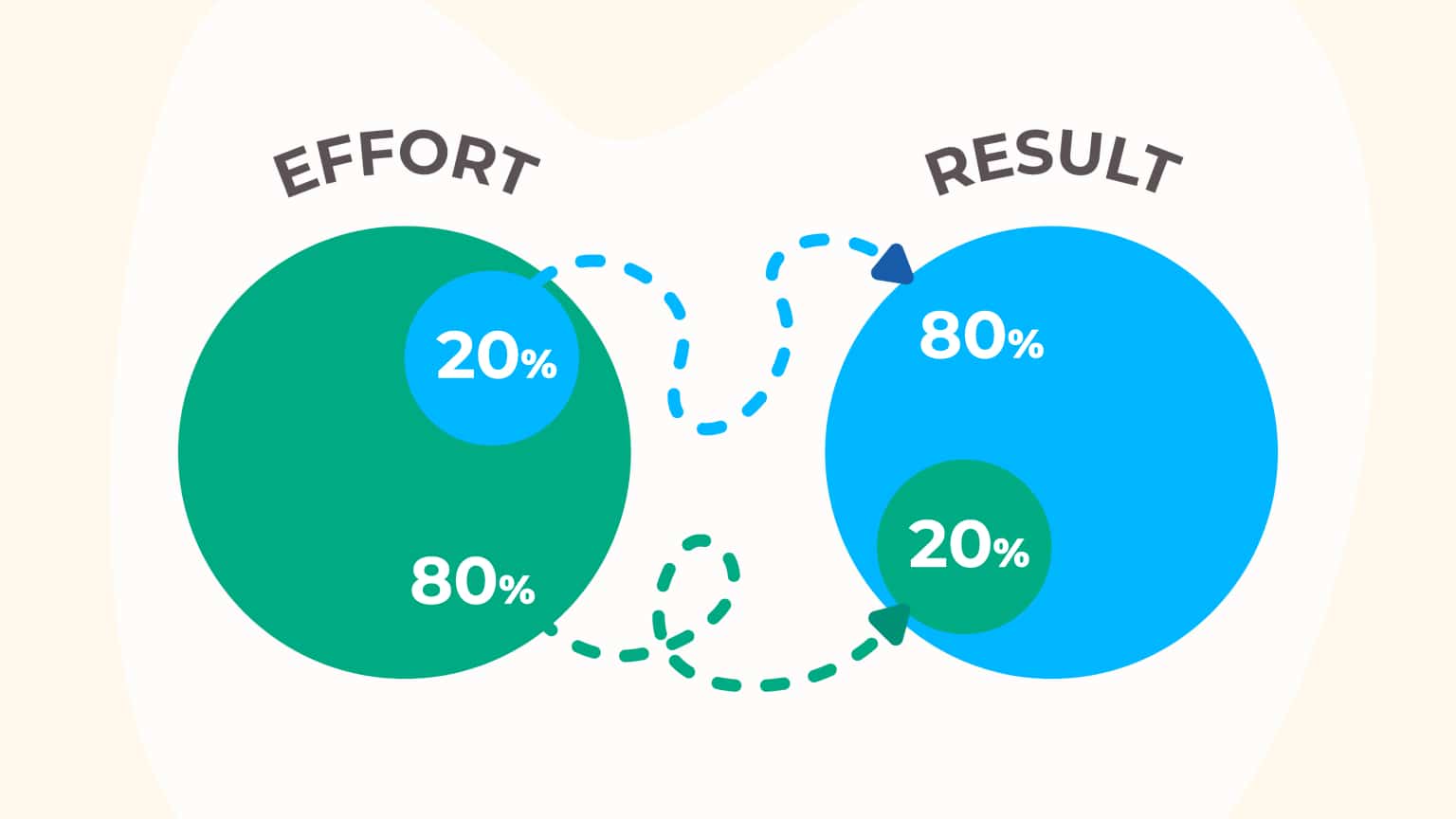The Pareto Principle, also known as the 80/20 rule, originates from the observations made by Italian economist Vilfredo Pareto in 1895. He discovered that 80% of the land in Italy was owned by only 20% of the population. This principle has since been applied to various fields, such as business and personal productivity. Essentially, the Pareto Principle suggests that a small number of inputs (typically 20%) significantly impact the outcomes (contributing to 80% of the results). In contrast, the remaining inputs have a much lesser effect.
The importance of the Pareto Principle in productivity cannot be overstated. Individuals and organizations can maximize their results with minimal effort by focusing on the critical 20% of tasks or inputs. This approach has become a powerful time management and decision-making tool, enabling people to prioritize their resources effectively, increasing efficiency and success.
To implement the Pareto Principle, one must first identify the most impactful 20% of tasks or inputs that contribute to most of their desired outcomes. Once identified, these should be prioritized, focusing time, energy, and resources on completing them. Meanwhile, the less significant 80% of tasks can be delegated, automated, or addressed with less urgency. Through this method, the Pareto Principle creates a more streamlined and effective approach to productivity in both personal and professional settings.
Origins of the Pareto Principle
Vilfredo Pareto’s Discovery
Italian economist Vilfredo Pareto made his groundbreaking discovery in the late 19th century when he observed a curious pattern in the distribution of wealth and land in his country. He noticed that 80% of the wealth in Italy was owned by 20% of the people. Upon further examination, he found this 80/20 distribution consistent in almost all countries he studied. The Pareto Principle was thus named after Pareto in recognition of his contribution to understanding this unequal relationship between inputs and outputs (source).
Pareto’s observation has since transcended its original application in the realm of economics. Over time, researchers and practitioners from various fields have found the 80/20 rule to apply to many different areas, asserting that 80% of consequences come from 20% of the causes (source).
The Pareto Principle has become a powerful tool for enhancing productivity and improving decision-making processes. By focusing on the 20% of inputs (or causes) that yield 80% of the outcomes (or outputs), decision-makers can prioritize resources and actions that will significantly impact their overall goals.
Key Concepts
Understanding 80/20 Rule
The Pareto Principle, also known as the 80/20 rule, is a concept founded by Italian economist Vilfredo Pareto. It states that roughly 80% of consequences come from 20% of causes, illustrating an unequal distribution of inputs and outputs. This principle can be applied across various domains, including wealth distribution, business, productivity, and quality control.
The 80/20 rule emphasizes that a small portion (around 20%) of your efforts, called the “vital few,” can yield a significant portion (80%) of your results. Focusing on the vital few can help increase productivity by identifying and capitalizing on these highly effective actions.
The Vital Few and The Trivial Many
The terms “vital few” and “trivial many” were coined by quality management expert Joseph M. Juran and are often used to describe the Pareto Principle’s application. The “vital few” refers to the 20% of inputs responsible for 80% of the outcomes, while the “trivial many” are the remaining 80% of inputs that contribute only 20% of the results.
In a coaching or productivity context, recognizing and prioritizing the vital few tasks can maximize the return on your actions. This approach can involve identifying the 20% of activities that bring about the most significant improvements or results and allotting more resources.
To implement the Pareto Principle effectively, consider the following steps:
- Identify the key tasks: List all your tasks, projects, or responsibilities and determine which activities bring the most value or results.
- Prioritize the vital few: Focus on the top 20% of activities that yield 80% of the rewards, allocating time and resources accordingly.
- Eliminate or minimize the trivial many: Assess the remaining 80% of tasks to reduce, delegate, or eliminate low-value activities, thereby streamlining your workload.
By applying the Pareto Principle, you can optimize productivity, direct your attention toward high-impact tasks, and ultimately achieve better outcomes in both personal and professional settings.

Pareto Principle in Business and Productivity
The Pareto Principle, also known as the 80/20 rule, is a concept that can significantly impact business productivity. By recognizing that 80% of outcomes often come from 20% of the inputs, businesses can focus on the most critical tasks and clients. This section discusses the Pareto Principle in specific business aspects: sales and marketing, time management, and quality assurance.
Sales and Marketing
The Pareto Principle suggests that 20% of a company’s customers might generate 80% of the revenue in the sales and marketing sphere. Knowing this, businesses can prioritize those clients, ensuring they receive the best service and targeted marketing efforts. Additionally, by identifying the top-performing 20% of marketing strategies, organizations can allocate more resources to executing these methods, leading to better results and overall efficiency.
Time Management
Regarding time management, the Pareto Principle can help employees focus on tasks with the most significant impact on productivity. By carefully analyzing their workday, employees can identify the tasks and activities that constitute the vital 20%, contributing to 80% of their results. This prioritization enables individuals and teams to efficiently allocate their time and resources to tasks leading to the most significant outcomes.
Quality Assurance
In quality assurance, the Pareto Principle often reveals that 80% of issues arise from 20% of the problems. Businesses can significantly improve their products or services’ quality by identifying and addressing the root causes of these defects. Utilizing Pareto Charts to visualize the distribution of issues helps teams detect areas demanding the most attention, leading to more targeted and effective problem-solving processes.
In conclusion, understanding and implementing the Pareto Principle across various aspects of a business can lead to increased productivity, better focus, and improved efficiency. By concentrating on the vital 20% of inputs, companies can drive more substantial outcomes and achieve their goals more effectively.
Pareto Analysis
Pareto Analysis is a technique that helps identify the most significant factors in a situation, based on the idea that 80% of the consequences (outputs) come from 20% of the causes (inputs) for any given event. This principle, also known as the 80/20 rule, was first observed by Italian economist Vilfredo Pareto and served as a foundation for productivity and optimization in various fields.
Pareto Chart Application
A Pareto chart visually represents the Pareto Principle, highlighting the most critical issues in a bar graph format. The bars represent the various factors, sorted by their impact, while the cumulative line plot shows the cumulative impact of the factors. This chart enables prioritization, focusing on the most significant factors or issues for efficient problem-solving. For instance, by identifying and resolving the top 20% of the factors, up to 80% of the problems can be addressed.
Optimization through Pareto Analysis
To improve productivity and reach the desired outcomes, Pareto Analysis can be utilized in the following manner:
- Identify inputs and outputs: List all the factors and their corresponding impacts. Inputs can be time, resources, or effort, while outputs are the measurable results or goals.
- Determine the relative importance: Assign each factor’s weight based on its contribution to the outcome or issue at hand. This step helps prioritize actions and select the most crucial factors to be addressed.
- Create a Pareto chart: Design a Pareto chart by arranging the factors in descending order of importance and their cumulative impact. This visual representation allows for easy identification of the critical 20% factors contributing to 80% of the results.
- Take targeted action: Focus on resolving the most significant factors identified in the analysis. Implement strategies and allocate resources efficiently to address these critical factors, optimizing workflow and productivity.
In summary, Pareto Analysis, backed by the visualization of a Pareto chart, facilitates decision-making and the optimization of resources by pinpointing the most impactful factors. Implementing strategies targeting these vital aspects leads to improved productivity and desired results.
Implementing the Pareto Principle
Task Prioritization
Implementing the Pareto Principle in task prioritization helps individuals and organizations to focus on the tasks that yield the highest results. Identifying the top 20% of tasks contributing to 80% of the desired outcomes allows more effective time management. To apply this principle, create a list of tasks and categorize them according to their impact on achieving goals. Focus on completing the high-impact tasks first while delegating, automating, or eliminating low-impact tasks whenever possible.
Enhancing Customer Service
In business, the Pareto Principle can be applied to enhance customer service by identifying the most valuable customers. These customers are often responsible for a large portion of a company’s revenue. Businesses can improve customer satisfaction and foster client loyalty by prioritizing the needs of the top 20% of customers. To achieve this, track customer interactions, purchasing data, and feedback. Use this information to tailor services, offers, and support specifically to the most valuable customers.
Employee Management
Applying the Pareto Principle in employee management involves identifying the top-performing employees who contribute significantly to a company’s success. Focusing on their development and providing the necessary resources and support can increase productivity and effectiveness. Creating a performance-based reward system can motivate these employees and encourage others to strive for similar results. This approach can also be used to pinpoint areas of improvement or new skill sets to develop among the workforce.
Benefits and Limitations
Advantages of the Pareto Principle
The Pareto Principle, also known as the 80/20 rule, states that 80% of outcomes often come from 20% of the related inputs1. This principle can be applied to various aspects of life, including business, project management, and decision-making.
One of the key advantages of the Pareto Principle is its potential to boost productivity2. When applied correctly, it enables organizations to identify the 20% of their efforts that generate 80% of the results. Companies can prioritize tasks, allocate resources effectively, and increase profitability by focusing on these efforts.
Additionally, the Pareto Principle promotes Pareto efficiency by ensuring that the allocation of resources results in the most optimal outcome3. This can lead to an improvement in overall success and land ownership for businesses and individuals. The principle also aids decision-making by offering a clear framework to prioritize projects and tasks based on their potential impact.
Potential Drawbacks
Despite its benefits, the Pareto Principle has some limitations that must be considered. For instance, the principle relies on the use of past data4, which may only sometimes be accurate or relevant to the current situation. Incorporating outdated information could lead to biased decision-making and reduced principle effectiveness.
Another limitation of the Pareto Principle is that it tends to ignore the qualitative aspects of a situation. While focusing on the most impactful 20% may result in significant benefits, it could also mean neglecting essential details with little immediate or quantifiable effects. This oversight can hinder the overall progress of a project or task.
Lastly, the Pareto Principle can lead to misconceptions if taken too literally. The 80/20 rule is not an exact science and may only sometimes hold true in some cases. Relying solely on this principle without considering other factors might lead to flawed decision-making and a false sense of confidence in the projected outcomes.
Case Studies
Pareto Principle in Software Development
The Pareto Principle has effectively identified and addressed critical problems in software development. Joseph Juran, a quality management guru, extended the principle in this domain, highlighting that 80% of software bugs are generated by 20% of the code or program features. By focusing on this 20%, developers can significantly improve a software program’s overall quality and performance.
For example, a software team can use data from bug-tracking systems to identify areas of the codebase with the highest number of reported issues. They can then concentrate on resolving these high-impact bugs, resulting in a more stable and reliable software product. This targeted approach allows teams to maximize productivity by allocating resources to the most critical issues.
Application in Manufacturing
The Pareto Principle has been widely applied in manufacturing to optimize resource allocation and decision-making processes. By identifying the 20% of factors or processes contributing to 80% of production inefficiencies, organizations can prioritize their efforts and focus on improving those elements that deliver the most significant results.
For instance, a manufacturing plant may analyze its production data to detect which equipment or stations are responsible for most delays or defects in the production line. By implementing targeted improvements in these critical areas, the plant can experience substantial enhancements in productivity, throughput, and product quality.
The Pareto Principle has proven to be valuable in software development and manufacturing, guiding professionals toward more focused and effective problem-solving strategies. By concentrating on high-impact areas, organizations can achieve better results with less time and resource investment.
Broader Applications and Final Thoughts
In Occupational Health and Safety
The Pareto Principle plays a significant role in occupational health and safety. By focusing on the 20% of hazards that cause 80% of accidents or injuries, organizations can significantly reduce risks and improve safety measures. This approach allows them to allocate resources effectively and efficiently, implementing targeted actions to decrease the likelihood of severe incidents. Organizations must identify these critical hazards and prioritize their mitigation, as it can protect employees from occupational health issues such as injuries and burnout.
Moreover, the Pareto Principle can also help manage workplace relationships. By focusing on the critical 20% of relationships, employers and employees can improve communication, increase job satisfaction, and reduce conflicts. This can lead to a healthier and more pleasant working environment for everyone involved.
In Daily Life
In addition to its applications in the work environment, the Pareto Principle can also be helpful in daily life. Individuals can significantly improve their overall productivity by identifying and focusing on the 20% of tasks or activities that yield 80% of desired results. This approach can help prevent burnout, as concentrating on what truly matters can reduce time spent on less meaningful tasks and the subsequent feeling of being overwhelmed.
Applying the Pareto Principle in daily life can also strengthen personal relationships. Individuals can better prioritize their social efforts and foster stronger connections with those who matter most by focusing on the crucial 20% of relationships that bring 80% of happiness and support.
In conclusion, the Pareto Principle has far-reaching applications for occupational health, safety, and daily life. Focusing on the key 20% of causes can address 80% of problems, improving productivity, safety, and personal well-being.




